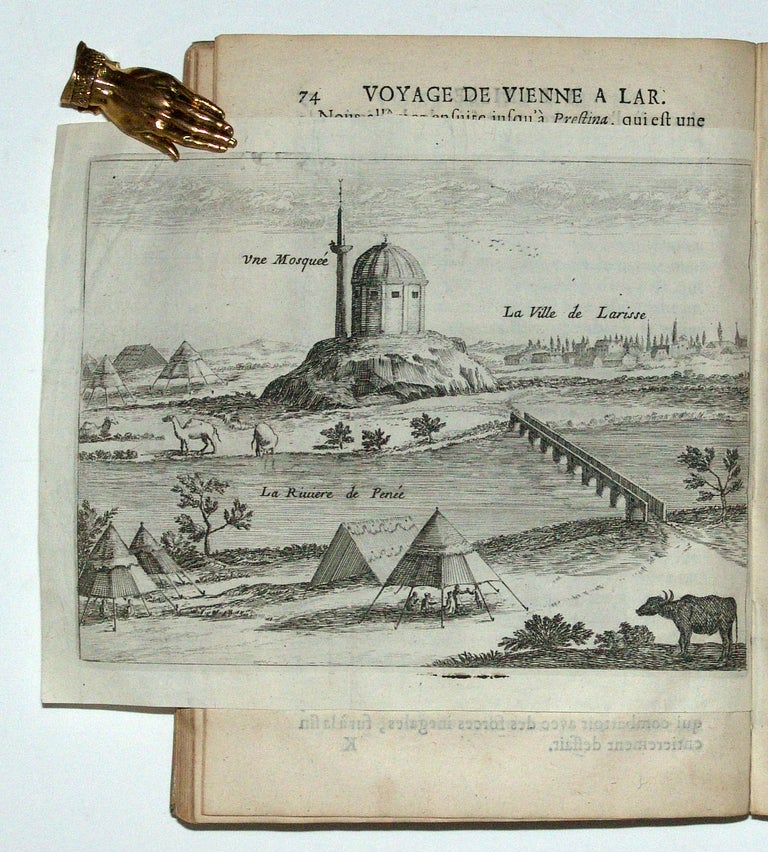
Relation de plusieurs Voyages faits en Hongrie, Servie, Bulgarie, Macedoine, Thesalie, Austriche, Styrie, Carinthie, Carniole & Friuli. .
4to., (4) ff., including engraved frontispiece signed L. Cossin after P. Mignard and title, 208 pp., including one woodcut in text, and with 9 plates, of which 3 are folding. Bound in contemporary stiff vellum. Some toning in outer margin of frontispiece and scattered leaves, but a fresh copy in its original binding. OCLC lists two copies of the French edition in North America: Yale and UVa. An expanded English edition appeared in 1685, as well as Dutch and German translations in 1682 and 1686. A separate volume devoted to his German travels was first published in 1677.
Scarce first French edition (expanded from the 1673 English original) of an early illustrated British travelogue to southeastern Europe and Greece. "This account is full of acute observations and judgments; of particular importance is the information he provides on mines and mining techniques" (Leonora Navari, Blackmer Catalogue 43). Embarking on his perambulations through Germany and southeastern Europe in 1668, a century before the Grand Tour became common among Englishmen, the young Dr. Brown travelled from Germany to the Balkans and beyond. Upon his return to England in 1673, he published his observations about Hungary, Thessaly, Macedonia, etc., regions which were as yet little known in England. The first printing was well received, causing Brown to append several additional chapters to this, the French translation.
As one of the first Englishmen to visit Greece, Brown is impressed both by the antiquities, which figure in the plates, and by the mythology. He spent time in Larissa, capital of Thessaly, in the shadow of Mount Olympus, and intermingles mythological details with historical facts. In his engraved view of the city, where camels and teepees line the banks of the Peneios River, a mosque dominates the town, reflecting the contemporary Turkish dominance in the region. Revealing the cultural, religious and ethnic diversity of the region, Brown mentions an extensive group of ambassadors and dignitaries who frequent the area, a degree of cosmopolitanism that may have surprised his northern European audience.
Brown's Relation ranges widely, providing information about local currencies, dining habits and hairstyle preferences for the various countries he passes through. He mentions the great quantities of Roman coins and medals he found in Hungary (pp. 29-31), and reveals his training as a physician by collecting specimens of medicinal herbs in Thessaly (p. 95). He documents the early cultivation of tobacco in Greece-used frequently by the Turks, they preferred the local crop rather than inferior imports (pp. 95, 118). He is also fascinated by a group of impoverished Christians troglodytes; he illustrates their surprisingly snug underground homes. A "philosophical" traveller, Brown represents expanded travel interests at that time, including those in ores and minerals. He devotes a considerable portion of the Relation to describing the history and geology of mining towns in what are now Hungary, Slovenia and Slovakia.
Edward Brown[e] (1644-1708), son of the physician and author of the Religio Medici, Sir Thomas Browne (1605-82), was a highly regarded doctor in his own right. He served as Physician-in-Ordinary to Charles II and was later appointed president of the Royal College of Physicians.
* * Blackmer II.43 (1673 English); Wing B5110 (1673 English); Weber 353 (1673 English); modern edition (ed. Karl Nehring, 1975); Hoover (1673 & 1685) 172-73.
Price: $4,500.00
